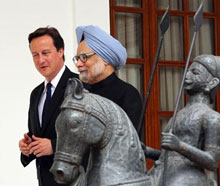Why India Matters
Investing in India makes sound Asia strategic sense when coupled with China
Op-Ed Commentary by Chris Devonshire-Ellis
 Jan. 4 – Much has been made of comparisons between China and India, much of it driven by the fact that the two nations are (occasionally reluctant) neighbors, their size, population and simultaneous development and progression. For two nations so large, sometimes at polar opposites, yet at the same time offering potentially comparable market sizes, is unprecedented in history. Yet here we are, 25 years on from the beginnings of China’s first, tentative steps towards reform, and India now looms on the horizon as a giant of Asia.
Jan. 4 – Much has been made of comparisons between China and India, much of it driven by the fact that the two nations are (occasionally reluctant) neighbors, their size, population and simultaneous development and progression. For two nations so large, sometimes at polar opposites, yet at the same time offering potentially comparable market sizes, is unprecedented in history. Yet here we are, 25 years on from the beginnings of China’s first, tentative steps towards reform, and India now looms on the horizon as a giant of Asia.
This phenomenon is not now purely restricted to these two nations either. A resurgent Russia, newly incorporated into the WTO will also change global trade dynamics in ways that have not even begun to be fully discussed. While media has concentrated on Russia’s political issues, the fact that another large consumer market and manufacturing base has emerged (albeit one smaller than China or India) has largely been ignored. Such ignorance betrays any understanding of global trade dynamics or the forces that will drive this century.
But back to India. As mentioned, much commentary concentrates on comparisons with China, and my firm and publications China Briefing, India Briefing and 2point6billion.com (the latter named after the combined populations of China and India) have been at the forefront of this. However, these comparisons are not purely restricted to the reasons I have given. A major point here is that the mainstream acceptance by global consumers, and especially the United States and Europe of China as both a source of product and a market to sell to has emboldened foreign firms in ways never seen before. Over the past 20 years, China has become mainstream, from investment to tourism. Travel anywhere in the West, and it has become commonplace to know someone who has visited the country. The dynamic has changed – when just two decades ago China was exotic, now it hogs the front pages of our major international news channels. This exposure, nay acceptance of China has provided the West with a new found confidence in exploring, investing in far off destinations, and educated us to accept perhaps the more exotic as the norm.
All this means that as foreign investment has poured into China, those same, emboldened investors are now more confident themselves about other markets – the most exotic of which is arguably India.
It is of note that of all India’s erstwhile suitors over the centuries, it was the British who made the most of their time there. Seemingly worlds apart, the British recognition of royalty in a time of Maharajahs, coupled with a military discipline and might, additionally armed with the famed Victorian “stiff upper lip” meant Britain was probably the only nation able to make sense of the country. As Stalin wryly observed, how Britain could run India with a force of just 10,000 appeared miraculous. Yet rule it they did, until independence in 1947.
It’s what happened next that actually makes it easier for contemporary foreign investors in China to get a handle on India today. The India of 1948 onwards, although a democracy, moved to a centrally planned economy and administration largely adopted from the communists of the Soviet Union. This means, curiously enough, that many of today’s business and legal administration processes throughout India are closer to that of China than to Britain.
But with a massive democracy comes problems, and India has long struggled to get its act together amid all the political quarreling and horse trading. Again, comparisons are made with China, and from many perspectives, with envious eyes – how great it must be to be able to govern and get your way without interruption. Yet despite this, India continues to move ahead.
That the country has an image problem is apparent however, and although the excellent “Incredible India” advertising campaign has done much to counter negative stereotypes concerning poverty, this issue remains impressionable upon many, and especially among those who have little experience of the country. But India is not like anywhere else, and certainly not like China, its colder neighbor to the Northeast. Much of India is tropical, and monsoonal in ways that are extreme. Heat and wet combined can make it a haven for disease and uncomfortable at least for the unprepared or naive. Yet over the past 10 years of extensive business travel throughout India, I only got the famed “Delhi Belly” once, and that was my own fault through stupidly taking a risk on a glass of water from a dubious source. Much of India offers hygiene, cleanliness, great food and drink without risk. If you backpack on a budget then you are taking risks – and then when the perils of doing so materialize, it’s always “India is dirty.” With a population of 1.28 billion and one of the highest birth rates in the world, the sheer statistics do not support India as being unhygienic to the extent it is often characterized. Let’s all wise up a little here.
The poverty issue is there however, but is diminishing. I arrived in Mumbai 25 years ago and the slums were everywhere. Many still exist – but not on the scale as before, and those that do are more the result of arcane land laws and political misrepresentation than indicative of the true state of affairs. Mumbai’s slums continue to exist largely as a result of political wrangling. That’s not to say it doesn’t require sorting out, because it does, but the background drivers are not abject filth as is commonly assumed. Another clue lies in India’s heat – people sleep outdoors simply because they can. I stopped and chatted one evening to a large population sleeping on the pavement along the seafront at Apollo Bunder in Mumbai. It turned out many owned million dollar mansions all the way along – sleeping outside was preferable to being cooped up indoors with the air-con blowing at full blast. Again, how India appears on the surface can be immensely deceiving.
All the comparisons and explanations over negative imagery aside, why does India matter? Here, it’s back to China again and simple demographics.
China has succeeded because 25 years ago it was able to match a desire for political reform with its age demographic – a ready supply of cheap, young labor. This is the primary driver as to why China became the export driven, cheap factory of the world’s demand. Today, that China dynamic is changing; the one child policy has driven down population growth (in fact China has slipped beneath the replacement level) and its working population is aging. This dynamic is shifting China towards a consumer based and more expensive society, and it cannot be changed.
Just as China moves away from being the world’s source of cheap manufacturing, India is stepping into the breach. The young, cheap labor force is progressively Indian, and when the world recovers from its economic turmoil, we will awaken to two decades of “made in India.”
The other dynamic India possesses is in its own consumer market. Unlike China when it began its path to reform, India already possesses a wealthy middle class, curiously estimated to be about the same size as China’s at 250 million.
These are the two statistics that matter: the population dividend and the consumer class. Another factor, albeit one that will in time disappear, is India’s need for redevelopment. That archaic infrastructure is in fact the opportunity for many investors, and India is offering contracts for everything from road, rail and airports to bridges, telecommunications and energy, just as China did 25 years back.
It is then high time to dust off those preconceived notions about India as dirty and poverty stricken. It’s far from being the case. Unlike most who pass judgement on the country, I’ve also put my money where my mouth is. Dezan Shira & Associates is entering its sixth year of operations there, and our 2012 budget for expansion in India is our most aggressive yet. I’m also relocating senior expatriate personnel from our China operations – where they are becoming an expensive luxury – to India. Their China expertise in foreign investment will be needed. In short, India isn’t competing with China. But it has arrived, and foreign investors now emboldened by their China experiences would do well to look how to duplicate that.
Chris Devonshire-Ellis is the principal of Dezan Shira & Associates. He established the firm’s operations in China in 1992, and the India operations in 2006. The practice now has 17 offices between the two countries and additional offices in Hong Kong, Singapore and Vietnam. Please contact the firm at india@dezshira.com for foreign direct investment market entry, legal and tax advise into the India market, or visit the firm’s web site here.
Related Reading
India GDP Growth to Overtake China in 2012
2012 China, India and ASEAN Growth to Stimulate FDI
The Beijing – Delhi Same-Same
Our photo essay comparing the two capitals
 Doing Business in India (Second Edition)
Doing Business in India (Second Edition)
This book aims to provide a basic overview of all topics related to doing business in India – history, business etiquette and culture, and how to invest into the country, in addition to a detailed, state-by-state demographic and geographic overview and a comparison with China.
 Developing Your Business from China to India and Vietnam
Developing Your Business from China to India and Vietnam
Our complimentary 25-page PDF report detailing cost analysis, labor and factory overheads comparisons between Dongguan, Chennai and Ho Chi Minh City, as well as an overview of other emerging Asian markets such as Cambodia and Laos. It includes full factory cost analysis, descriptions of the legal establishment differences and options, the tax implications in these markets, as well as business and cultural differences. This is a must read for all executives interested in expanding into Asia.
- Previous Article Beijing Applies for Implementation of VAT Reform Pilot Project
- Next Article 253 Items of Administrative and Institutional Fees Pertaining to Enterprises Cancelled

























